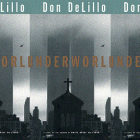Writ in Water: Millimeters to the End of the World

How do you write about the end of the world? Or avoiding the apocalypse? The drying up of our water or our overdue adaptation to living with less? How do you imagine—and make real—global superstorms and cities swallowed by the sea and the hottest summers on record? And how, at its best, can that writing save us?
“You write in order to change the world, knowing perfectly well that you probably can’t, but also knowing that literature is indispensable to the world.” It’s one of James Baldwin’s best lines. “The world changes according to the way people see it, and if you alter even by a millimeter the way people look at reality, then you can change it.”
This is a hope particularly fitting for the work of the Imagination and Climate Futures Initiative at Arizona State University. Partnering with the Center for Science and the Imagination, the Rob and Melani Walton Sustainability Solutions Initiatives, and the Virginia G. Piper Center for Creative Writing, the initiative established the Climate Fiction Short Story Contest to encourage writers around the world to explore the human experience of climate change.
“The center generally does research-based storytelling, getting experts and creative writers together at the inception of a story idea to ground the story in science, technology, and social policy. But we also don’t want the story to seem too meticulously fact-checked to take the blood out of it,” says Joey Eschrich, the Center for Science and the Imagination’s editor and program manager. Particularly when discussing climate change, when the concerns are truly global and the repercussions potentially distant or diffuse, he says,
“It’s really hard to get people to relate, to put themselves into the story of climate change. It’s just too colossal and abstract. In day to day reality, it doesn’t seem real…How do you make this more real for people?”
The contest has chosen its twelve finalists, and next month the winner will be announced along with the release of the contest anthology. The anthology features the twelve selected stories, a foreword from acclaimed author Kim Stanley Robinson, and an interview with climate fiction writer Paolo Bacigalupi. Though the stories were asked to speculate on futures for our planet, their authors were also asked to contend with the realities of today’s writing world: Eschrich says the contest received nearly 750 submissions from 67 countries, many of them at the beginning of the contest window, which he thinks suggested a previous lack of recognition and homes for these stories.
“I expected a lot of polar bears stories, and we did get a lot of polar bear stories, and stories about islands. There were a lot of salvaging stories too. But the theme of people being really resentful of their parents’ and grandparents’ generations and not really being able to do anything with that anger was a major theme,” Eschrich explains. “There’s a story about disaster tourism, this whole economy that grows up around this village, and westerners arriving and wanting to see the coral reefs before they fall apart…There’s also a story about this young couple deciding whether to have a kid or not. This is a near-future world where there’s been a lot of sea level rise. What makes it great at the level of ideas is the kind of ethical questions this couple has to answer.”
True to the center’s philosophy of “thoughtful optimism,” Eschrich says the judges tried to avoid the narrative extremes—fantastical stories about ice planets and magical characters and, in turn, “information dump” stories that were overly preachy or didactic—to find engaging entries grounded in scientific and technological truth. “I think in a lot of cases the point of hopefulness in the stories is the resilience of communities or the ability of people to adapt and muddle through…I think people are going to respond to these human stories about people making difficult choices.” And true to its collaborative mission, the center left the difficult choices of judging the contest to experts in multiple fields.
Dr. Manjana Milkoreit, a coordinator of the contest and initiator and former director of the Imagination and Climate Futures Initiative (and now an assistant professor of political science at Purdue University), explains she was reading as an expert and as a reader. “I was certainly reading the stories as a reader—is this is fascinating, well-written story that can hold my attention? Did I enjoy the reading experience? My scientific knowledge about climate change was at play as well; I expected the stories to be somewhat aligned with our current understanding of how climate change will play out. But most importantly, I was looking for stories that really explored in a vivid and emotional fashion how climate change could shape and affect the life experience of individuals and the ways our societies might look and function in the future. For me this was all about imagining how the links between environmental changes and social changes will play out in the future and the ability to help the reader ‘see’ and ‘live in’ these possible futures.”
For Meredith Martinez, Education Programs Manager at the Virginia G. Piper Center for Creative Writing, judging as a contest administrator also allowed her to read as a fellow writer. “As a judge, I was most excited by stories in which a future situation of a society transformed by climate change was crucial to the human drama unfolding in the story’s pages. In other words, I was looking for stories in which climate change was not merely a backdrop or a context, but was a powerful determiner in how characters in the story thought, acted, and configured their values. I suppose, in this sense, I was reading as a writer, in that I was looking for how thoroughly and originally an author cast his or her imagination forward into the future, and how well the author wedded this imagined future to the action of the story and to the characters involved in the action.” She adds,
“Of course, along these lines, another thing that good fiction does so beautifully is allow a reader to vicariously experience what is impossible, or implausible, for him or her to undergo in normal life, and to rehearse emotions surrounding that experience.”
Science fiction luminary Kim Stanley Robinson helped judge the contest’s finalists, and his foreword will introduce the anthology released next month. I asked him about the labels for this kind of writing. What is science fiction, or fiction generally, when grappling with climate change? “Any story set in the future is science fiction, that’s the definition, at least to me. So it’s right to call these stories that portray imagined futures as science fiction, of course. And science fiction has very often described futures that include a changed climate as one element of the scenario being described—this goes back to Verne and Wells, and it was a regular feature of British postwar sf, as with John Wyndham and JG Ballard.”
“It’s becoming more prominent now because climate change is already happening and global warming will be with us no matter what we do now, though what we do now matters hugely in how bad the impacts will be,” Robinson says. “So now, any near future realist sf, which is only one subgenre among many, has to include climate change just to be a realistic scenario. You can call this climate fiction if you like, but really it’s just near future science fiction doing its job.”
“We have a massive public engagement problem when it comes to climate change,” Milkoreit says. “There are many reasons for that, but one is the mind’s reluctance to engage with negative, threatening, overwhelming information. Climate fiction can break through this cognitive and emotional barriers—often with ease—because it transports the reader into a ‘safe’ fictional world and provides a whole lot of fun and reading pleasure along the way.”
James Baldwin talks change in millimeters. Scientists do too—less rain, higher sea levels, concentrations of pollution, melting ice caps—and see ahead of these tiny and unabating steps a frightening future. Fiction sees change in its characters, in the closeness of their lives and bigness of their loves and losses, for which there is no precise scale. The message is clear: when we talk and write about climate change, measurements matter. Making those measurements meaningful matters even more.
“I don’t know if I can confidently claim that a single story or extended narrative may excite major alterations in policy or awareness,” says Martinez. “But I think a literary movement that asks readers to practice empathy for different populations, around the world and closer to home, who may face irreparable losses in the rather near future — well, I think that’s a movement with possibility, and we hope that our contest supports it by encouraging folks, not only to consume the literature, but to create it as well.”



